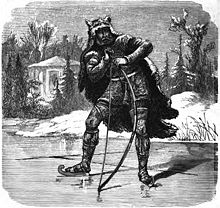| Revision as of 17:03, 5 June 2024 editQueen of Hearts (talk | contribs)Edit filter managers, Autopatrolled, Administrators33,120 edits {{harvnb}}← Previous edit | Revision as of 21:41, 9 June 2024 edit undoQueen of Hearts (talk | contribs)Edit filter managers, Autopatrolled, Administrators33,120 edits better match original styleNext edit → | ||
| Line 3: | Line 3: | ||
| {{For|the album by Skálmöld|Ýdalir (album)}} | {{For|the album by Skálmöld|Ýdalir (album)}} | ||
| ].]] | ].]] | ||
| In ], '''Ýdalir''' ("]-]"<ref name=ORCHARD185>{{ |
In ], '''Ýdalir''' ("]-]"<ref name=ORCHARD185>{{harvcol|Orchard |1997|p=185}}.</ref>) is a location containing a dwelling owned by the god ]. Ýdalir is solely attested in the '']'', compiled in the 13th century from earlier traditional sources. Scholarly theories have been proposed about the implications of the location. | ||
| ==Attestations== | ==Attestations== | ||
| Line 11: | Line 11: | ||
| :has himself a dwelling made. | :has himself a dwelling made. | ||
| :] the gods ] gave | :] the gods ] gave | ||
| :in days of yore for a tooth-gift.<ref name=THORPE21>{{ |
:in days of yore for a tooth-gift.<ref name=THORPE21>{{harvcol|Thorpe|1907|p=21}}.</ref> | ||
| </blockquote> | </blockquote> | ||
| ==Theories== | ==Theories== | ||
| Discussing Ýdalir, ] comments that "the wood of the yew-tree was used for bows in the North just as it was long afterwards for England."<ref name=BELLOWS88>{{ |
Discussing Ýdalir, ] comments that "the wood of the yew-tree was used for bows in the North just as it was long afterwards for England."<ref name=BELLOWS88>{{harvcol|Bellows|2004|p=88}}.</ref> ] says that "this connexion of the god with the yew-tree, of whose wood bows were made (cf. ON ''ýbogi'' 'yew bow'), has led to Ullr being seen as a bow-god."<ref name=SIMEK375>{{harvcol|Simek|2007|p=375}}.</ref> Andy Orchard comments that Ýdalir is an "aptly named dwelling-place ]-god, Ull."<ref name=ORCHARD185/> According to ], while Valhalla "is well known because it plays so large a part in images of warfare and death," the significance of other halls in Norse mythology such as Ýdalir, and the goddess ]'s afterlife location ] has been lost.<ref name=DAVIDSON199367>{{harvcol|Davidson|1993|p=67}}.</ref> | ||
| ], located in ], ], is first recorded in 1578, and is thought to derive from Old Norse ''y-dalr''. Robert Bevan-Jones proposes a connection between veneration of Ullr and Ýdalir among the settling pagan Norse in Scotland and their bestowment of the name ''ydalr'' to the location.<ref name="BEVAN-JONES134">{{ |
], located in ], ], is first recorded in 1578, and is thought to derive from Old Norse ''y-dalr''. Robert Bevan-Jones proposes a connection between veneration of Ullr and Ýdalir among the settling pagan Norse in Scotland and their bestowment of the name ''ydalr'' to the location.<ref name="BEVAN-JONES134">{{harvcol|Bevan-Jones|2002|p=134}}.</ref> | ||
| ==Notes== | ==Notes== | ||
Revision as of 21:41, 9 June 2024
Mythological location For the album by Skálmöld, see Ýdalir (album).

In Norse mythology, Ýdalir ("yew-dales") is a location containing a dwelling owned by the god Ullr. Ýdalir is solely attested in the Poetic Edda, compiled in the 13th century from earlier traditional sources. Scholarly theories have been proposed about the implications of the location.
Attestations
Ýdalir is solely attested in stanza 5 of the poem Grímnismál (collected in the Poetic Edda), where Odin (disguised as Grímnir) tells the young Agnar that Ullr owns a dwelling in Ýdalir. The stanza reads (Ýdalir is here translated as Ydalir):
Theories
Discussing Ýdalir, Henry Adams Bellows comments that "the wood of the yew-tree was used for bows in the North just as it was long afterwards for England." Rudolf Simek says that "this connexion of the god with the yew-tree, of whose wood bows were made (cf. ON ýbogi 'yew bow'), has led to Ullr being seen as a bow-god." Andy Orchard comments that Ýdalir is an "aptly named dwelling-place archer-god, Ull." According to Hilda Ellis Davidson, while Valhalla "is well known because it plays so large a part in images of warfare and death," the significance of other halls in Norse mythology such as Ýdalir, and the goddess Freyja's afterlife location Fólkvangr has been lost.
Udale, located in Cromarty, Scotland, is first recorded in 1578, and is thought to derive from Old Norse y-dalr. Robert Bevan-Jones proposes a connection between veneration of Ullr and Ýdalir among the settling pagan Norse in Scotland and their bestowment of the name ydalr to the location.
Notes
- ^ (Orchard 1997:185).
- (Thorpe 1907:21).
- (Bellows 2004:88).
- (Simek 2007:375).
- (Davidson 1993:67).
- (Bevan-Jones 2002:134).
References
- Bellows, Henry Adams (Trans.) (2004). The Poetic Edda: The Mythological Poems. Courier Dover Publicans. ISBN 0-486-43710-8
- Bevan-Jones, Robert (2002). The Ancient Yew: A History of Taxus baccata. Windgather Press. ISBN 0-9538630-4-2
- Davidson, Hilda Roderick Ellis (1993). The Lost Beliefs of Northern Europe (illustrated edition). Routledge. ISBN 0-415-04937-7
- Thorpe, Benjamin (Trans.) (1907). The Elder Edda of Saemund Sigfusson. Norrœna Society.
- Orchard, Andy (1997). Dictionary of Norse Myth and Legend. Cassell. ISBN 0-304-34520-2
- Simek, Rudolf (2007) translated by Angela Hall. Dictionary of Northern Mythology. D.S. Brewer. ISBN 0-85991-513-1
Category: